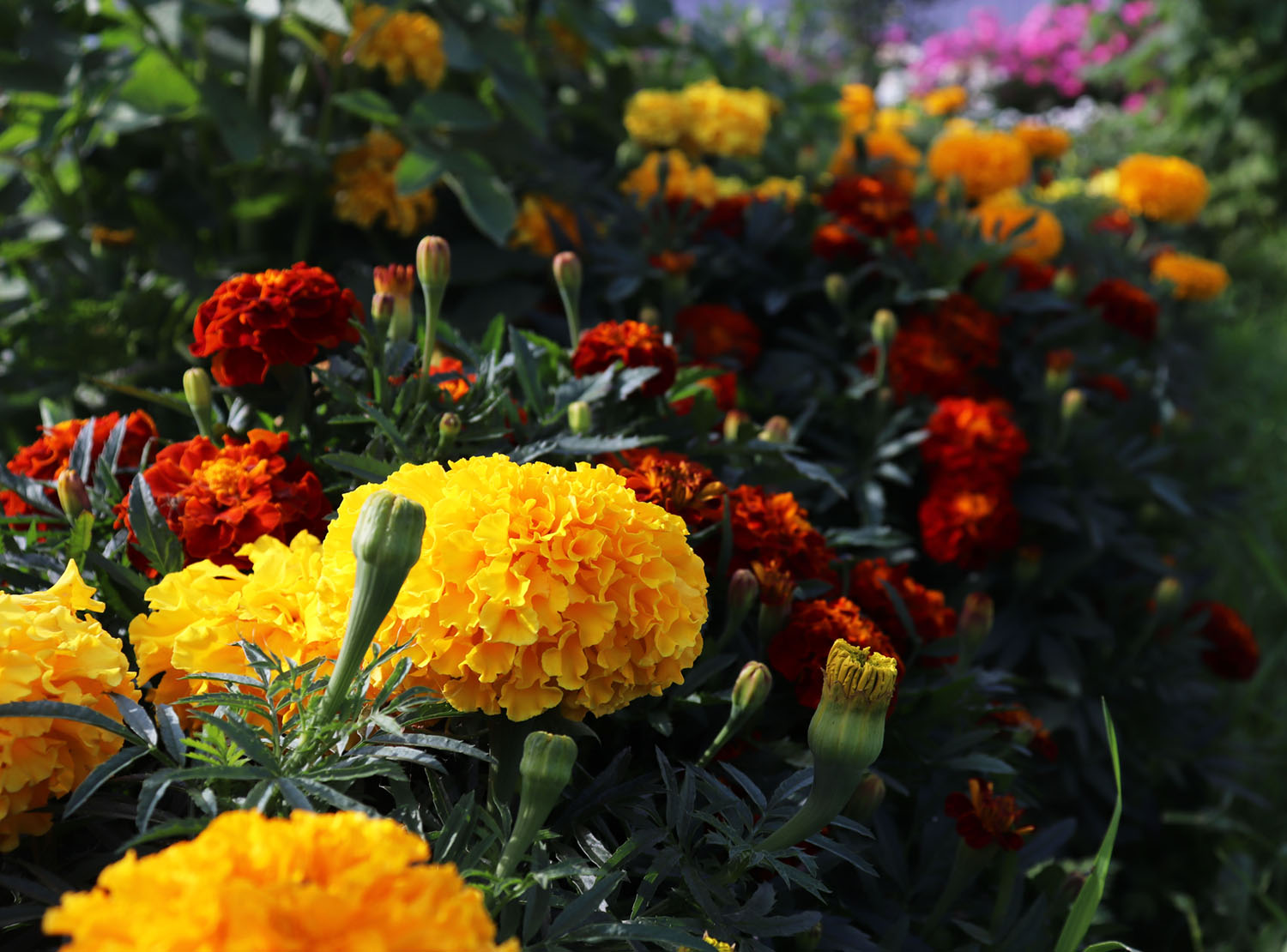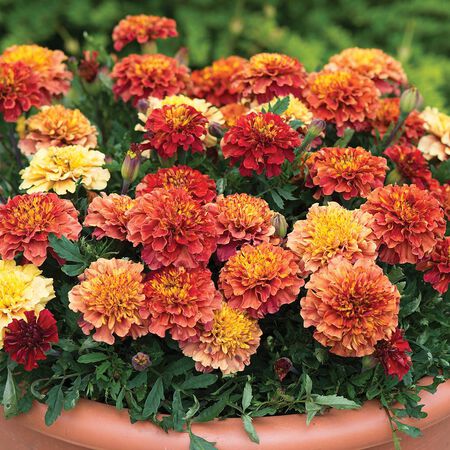
Photo by achumakoff723 / Shutterstock
Available in a range of warm hues, marigolds brighten any garden. Learn about growing conditions, cultural traditions, and types of marigolds.
Easy, breezy marigolds. Give them the right conditions and watch them spill over your borders and containers. They love full sun, (not overly) fertile soil, and will provide color for months, from the heat of summer until the chill of the first frost. Monarch butterflies love them, too! If you are just getting into gardening, welcome to growing one of the most popular annuals out there.
Even the experts will tell you that marigolds are easy to sprout from seed. Texas-based flower-farming pioneers, Frank and Pamela Arnosky have owned Arnosky Family Farms since 1992, where they produce thousands of mixed bouquets and single-flower bunches a week.
“Plant the seed, cover lightly, and water it in,” encourages Pamela. “They’ll sprout in a few days. Although they can be planted whenever the threat of frost has passed, they really thrive in the late summer and early fall, when the days are growing shorter, and the temperatures are still warm.”

Photo courtesy of Arnosky Family Farms
A field full of Chedi marigolds, one of the taller types of marigolds, are grown commercially at Arnosky Family Farms.
A TRUE CLASSIC
Marigolds have been grown for over 2,000 years. All types, despite common names referencing other locales, are native to subtropical America, belonging to the same family as sunflowers and daisies. With colors stretching from bright yellows to deep ambers and reds, along with creamy whites and bicolored selections, their shades are unmistakable. So much so that marigolds (or cempazuchitl) serve as the traditional flower for Día de los Muertos (Day of the Dead), the Latin American holiday celebrated on November 1. It is believed that their sunset colors and musky smell lead the souls of the dead to the paths of their loved ones. At Arnosky Family Farms, they dedicate seven acres to growing marigolds for Día de los Muertos!
Marigolds are also honored during Bathukamma, an Indian floral festival celebrated in the state of Telangana. The tradition goes like this: Men and boys pick the wildflowers, and women prepare them in a striking arrangement (called Bathukamma) to honor the bond between people and nature. Their saffron shades are also a welcome part of Diwali, India’s well-known Festival of Lights, where the blooms are featured in garlands, hanging from the doors and windows of homes, as well as rangolis (an art form in which vibrant designs are made on the floor using flowers and other natural materials).

Photo by Toa55/Shutterstock
Marigolds are featured in a flower rangoli for Diwali.
TYPES OF MARIGOLDS
African marigolds (Tagetes erecta) are the taller of the two, growing up to three feet, with double blooms as big as five inches in diameter. Dense leaves appear ruffled against their dark green foliage, and they are usually staked to provide support. Try the Jedi series, with huge orange blooms that are known for their long vase life. While African marigolds have a reputation for producing a less-than-desirable smell, the Jedis produce a milder, citrusy scent.

Photo courtesy of The Flower Hat
Julio Freitas with a huge bunch of Jedi Orange, a variety of African marigolds.
“Jedi is one of my absolutely favorite varieties of marigolds to grow,” said Julio Freitas, owner of The Flower Hat, a floral design studio and flower farm located in Bozeman, Montana. “The plants are prolific, producing a number of large blooms, each displaying the quintessential, rich marigold hues we’ve all come to love.”
Freitas reminded us that these gals are tall, so arrange them in the back of your garden for a bold and bright display of yellows, whites, golds, and oranges. You can grow Jedis in large containers, too.
“I’d recommend honoring the orange by partnering Jedi marigold with analogous colors to create a rich summer planter,” Freitas advised. “Pair it with Carex comans ‘Milk Chocolate’, marigold ‘Strawberry Blonde’ (a French marigold), and phlox ‘Dulce de Leche’. Finish the look with some trailing chartreuse sweet potato vines and deep-gold petunias or calibrachoa.”

Photo courtesy of Urban Farmer
The pink hues in the Strawberry Blond French marigolds make a sunset-colored container of marigolds pop.
French Marigolds (Tagetes patula), with their small and bushy nature, make perfect choices for front-row borders, and they love a container, too. While being compact, their height ranges from 6 to 18 inches.
The blooms of French types of marigolds can be single, anemone, or crested, in shades of yellow, orange, or mahogany-red. The singles have one outer row of petals, while the anemone types feature flat outer petals with a ruffled center. The crested types have shorter petals with dense ruffles.
If you live in a rainy area, try planting French marigolds. They do much better in wet conditions than African marigolds.
EDIBLE OPTIONS
While most types of marigolds are technically edible, for the most pleasant flavor, try these two wild varieties.
Sweet-scented marigold (Tagetes lucida) is used as a substitute for French tarragon, and its distinct fragrance is like anise. With a backdrop of lime-green foliage, expect a height range of 18-30 inches. Other common names for these dainty, yellow flowers include sweet mace, sweet-scented marigold, Mexican mint marigold, and Spanish tarragon.
Signet marigold (Tagetes tenuifolia) grows freely across most of Mexico, as well as Central America, Colombia, and Peru. It features tiny, single, yellow flowers. Like all marigolds, it prefers a sunny location and well-drained soil that’s not over fertilized. This species is also known as golden marigold or lemon marigold.

Photo courtesy of
You can eat the flowers of signet marigolds, making this wild-child species a fun choice for a culinary display.
By Jennifer H. Daniel
PLANT A FALL CONTAINER
A fall container garden is easy to assemble but makes a big statement from September through first frost. Ours overflows with vibrant autumn hues, including ‘Hot Pak Harmony’ French marigolds, ornamental pepper, coleus, cosmos, calibrachoa, and iresine. See more.

Photo by Jessica Cohen



